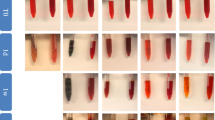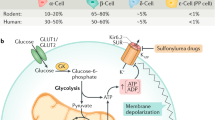Abstract
IT has been shown by histological methods1 that the islets of Langerhans form a much larger proportion of the pancreatic tissue in fœtuses and newborn infants than they do in adults, and Fisher and Scott2 extracted relatively more insulin from the pancreas of the fœtal and newborn calf than from the same organ in later life. Hartmann and Jaudon3 found that the injection of insulin into newborn human infants led to a moderate fall of blood sugar, and Villee4 has stated that the fœtal tissues of man respond in vitro, like those of adults, to the presence of added insulin by an increased utilization and oxidation of glucose. The newborn infant, therefore, would appear to have abundant islet tissue and to respond normally to insulin; and in keeping with all this is the well-known fact that newborn infants may have very low fasting blood-sugars5.
This is a preview of subscription content, access via your institution
Access options
Subscribe to this journal
Receive 51 print issues and online access
$199.00 per year
only $3.90 per issue
Buy this article
- Purchase on Springer Link
- Instant access to full article PDF
Prices may be subject to local taxes which are calculated during checkout
Similar content being viewed by others
References
Nakamura, N., Virchows Arch., 253, 286 (1924).
Fisher, A. M., and Scott, D. A., J. Biol. Chem., 106, 305 (1934).
Hartmann, A. F., and Jaudon, J. C., J. Pediat., 11, 1 (1937).
Villee, C. A., Biology, 19, 186 (1954).
Smith, C. A., “The Physiology of the Newborn Infant” (2nd edit., Charles C. Thomas, Springfield, Illinois, 1951).
Himwich, H. E., Fazekas, J. F., and Homburger, E., Endocrin., 33, 96 (1943). Passmore, R., and Schlossmann, H., J. Physiol., 92, 459 (1938). Schlossmann, H., J. Physiol., 92, 219 (1938).
Groen, J., Kamminga, C. E., Willebrands, A. F., and Blickman, J. R., J. Clin. Invest., 31, 97 (1952).
Randle, P. J., Brit. Med. J., i, 1236 (1954).
Randle, P. J., in “The Hypophyseal Growth Hormone—Nature and Actions” (McGraw-Hill, New York, 1955).
Author information
Authors and Affiliations
Rights and permissions
About this article
Cite this article
SANTOS, R., McCANCE, R. & RANDLE, P. Insulin Activity of Cord Plasma. Nature 176, 115–116 (1955). https://doi.org/10.1038/176115c0
Issue Date:
DOI: https://doi.org/10.1038/176115c0
This article is cited by
-
Free and bound insulin in pregnancy and labor
Bulletin of Experimental Biology and Medicine (1965)
-
Insular function of mother and fetus
Bulletin of Experimental Biology and Medicine (1963)
-
The insulin activity of the blood plasma in female and newborn rabbits during alloxan diabetes induced at different periods of pregnancy
Bulletin of Experimental Biology and Medicine (1962)
-
The pituitary growth hormone and metabolic processes
Ergebnisse der Physiologie Biologischen Chemie und Experimentellen Pharmakologie (1957)
Comments
By submitting a comment you agree to abide by our Terms and Community Guidelines. If you find something abusive or that does not comply with our terms or guidelines please flag it as inappropriate.



